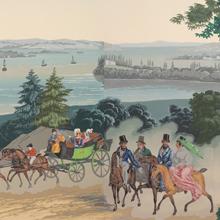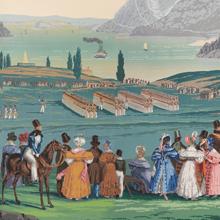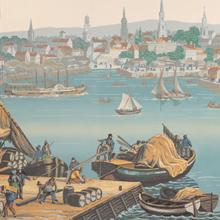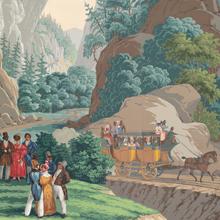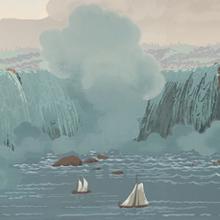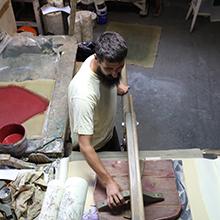International Terminal

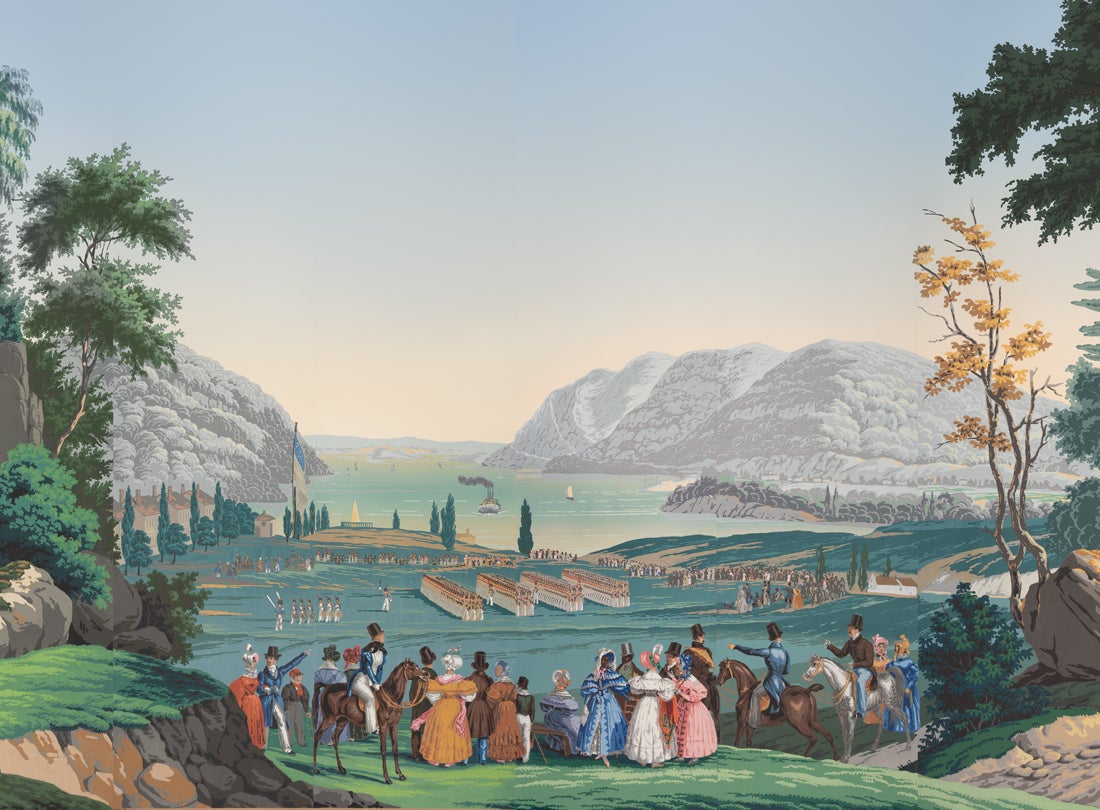
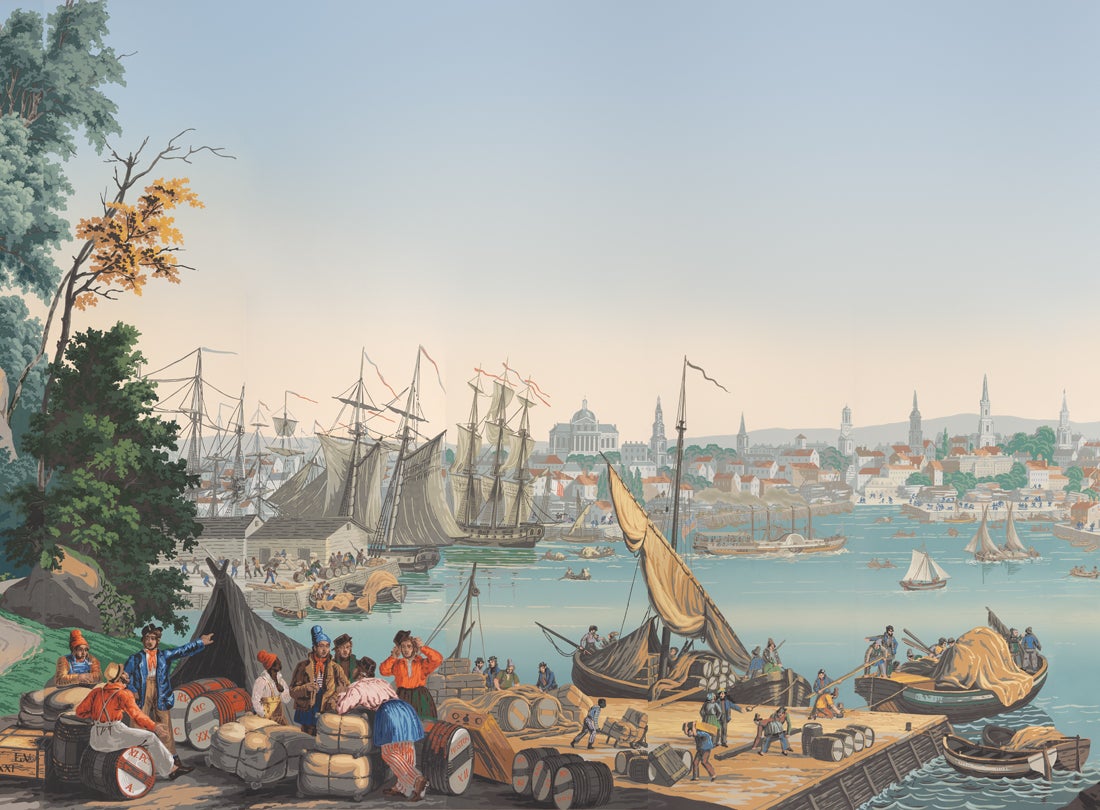
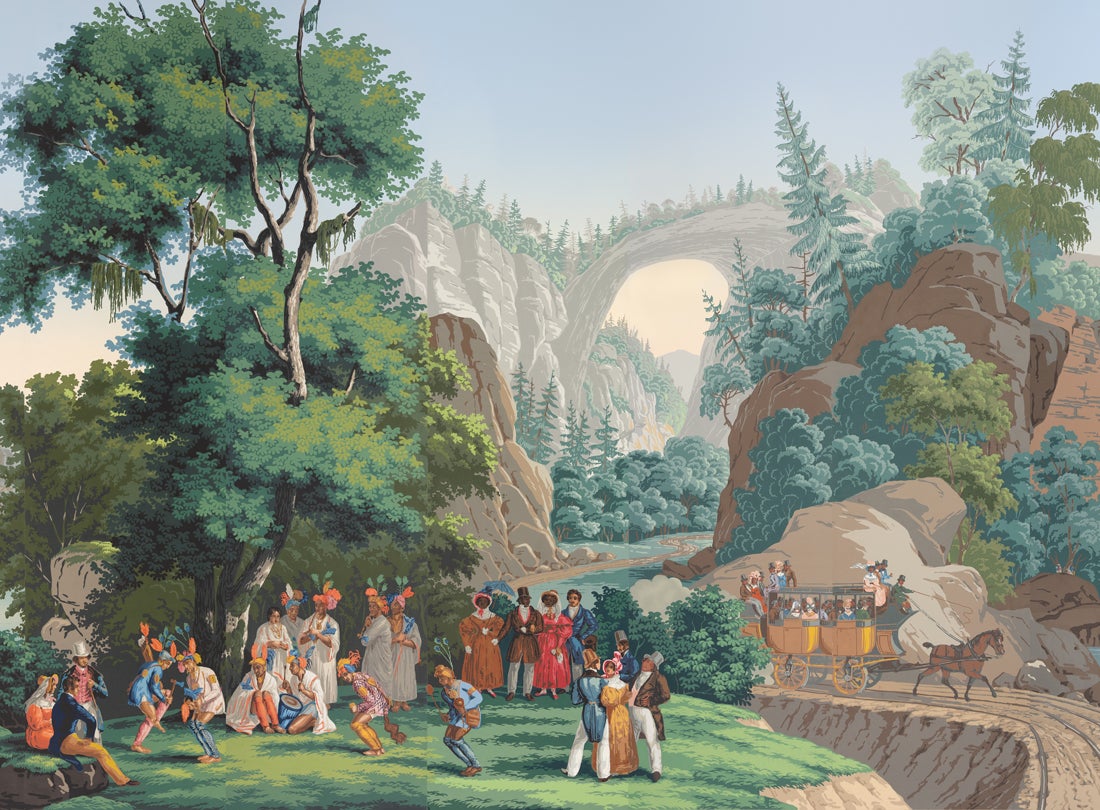
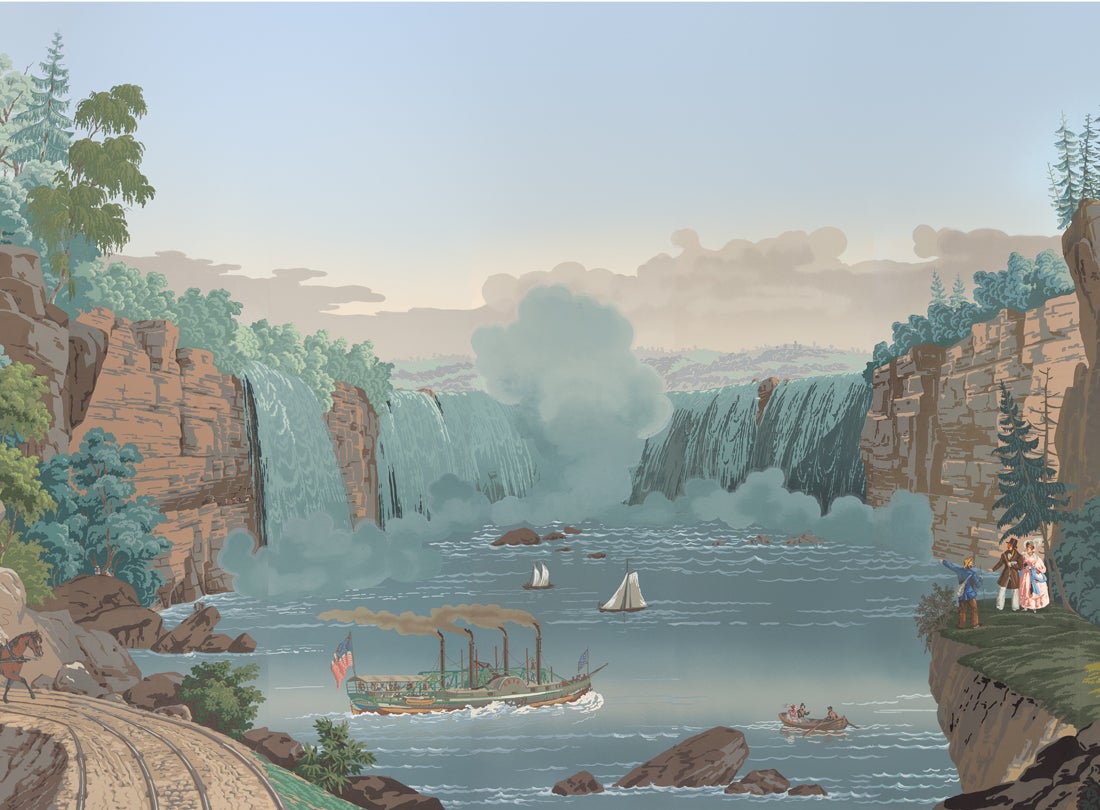
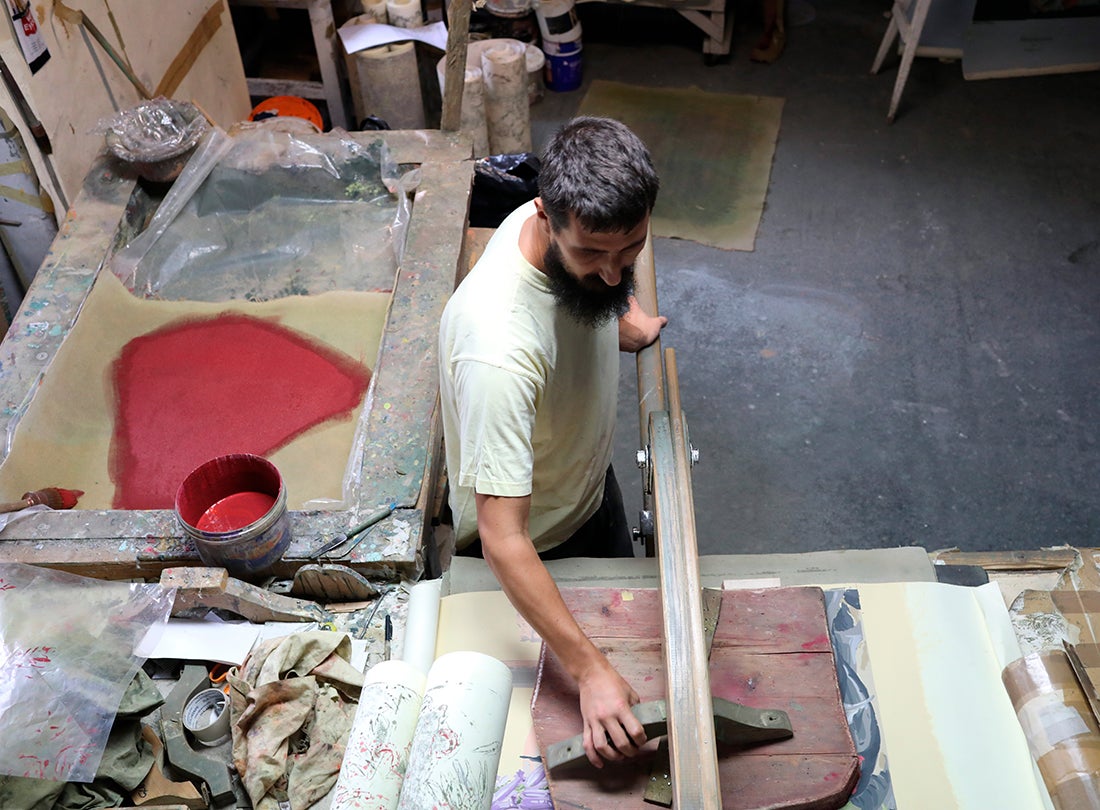
Views of North America lengths 1–6 c. 2018 (first edition 1834)
“View of New York Bay from New Jersey”
Designed by Jean-Julien Deltil (1791–1863)
1,690 printing blocks, 223 colors, and 32 lengths
Zuber et Cie
Rixheim, France
Courtesy of Zuber et Cie
L2019.0301.001.01-.32
Les Vues d’Amérique du Nord
Designed by Jean-Julien Deltil (1791–1863), and inspired by Jacques-Gérard Milbert’s (1776–1840) published lithographs, Zuber introduced Les Vues d’Amérique du Nord (Views of North America), historically referred to as Scenic America, in 1834. It requires 1,690 printing blocks, 223 colors, and thirty-two lengths totaling forty-nine feet. A French portrait of the New World in the 1830s, it features several idealized scenes beginning with "New York Bay" as seen from New Jersey; a grand stagecoach passes by leisurely strollers. In the next scene, “Military Review at West Point,” U.S. Military Academy cadets form a procession at West Point along the Hudson River with the Catskill mountains in the backdrop. This is followed by a bustling view of "Boston Harbor." Next, Virginia’s Natural Bridge forms a backdrop for an amalgamation of Native Americans, free African Americans, and whites. Finally, the scenic culminates with a sublime natural wonder—"Niagara Falls"—the ultimate North American tourist destination. A technological marvel at the time, a steam-powered boat pushes past the falls. Views of North America was particularly popular with Europeans fascinated by the burgeoning democracy and its intriguing landscape and peoples. The scenic wallpaper later charmed an American audience who viewed it as a nostalgic portrait of preindustrial life in the United States. It was papered in homes and hotels in the late nineteenth and early twentieth centuries and again captured the nation’s attention when First Lady Jacqueline Kennedy installed a historic set in the White House in 1961.

“View of New York taken from Weahawk”
Isidore-Laurent Deroy after a drawing by Jacques-Gérard Milbert
Picturesque Itinerary of the Hudson River and the Peripheral Parts of North America (1828–29)
Jacques-Gérard Milbert (1776–1840)
published in the United States by Gregg Press, Ridgewood, New Jersey (1968)
R2019.0308.001
Views of North America lengths 8–13 c. 2018 (first edition 1834)
“Military Review at West Point”
Designed by Jean-Julien Deltil (1791–1863)
1,690 printing blocks, 223 colors, and 32 lengths
Zuber et Cie
Rixheim, France
Courtesy of Zuber et Cie
L2019.0301.001.01-.32
Jacques-Gérard Milbert’s Lithographs
Jacques-Gérard Milbert’s (1776–1840) published lithographs provided the inspiration for the five scenes in Views of North America. Employed as an engineer with the Erie Canal Commission, Milbert also traveled throughout the northeastern United States from 1815 to 1823. While in North America, he collected flora and fauna specimens for the Museum of Natural History in Paris and documented the landscape, social customs, and technological marvels he observed. Upon returning to France, Milbert published Picturesque Itinerary of the Hudson River and the Peripheral Parts of North America in 1828 and 1829, a 569-page book with fifty-four lithographs.
Designer Jean-Julien Deltil (1791–1863) most likely never visited North America. Instead, he drew freely from five of Milbert’s published lithographs to design his fanciful scenic wallpaper, enlivening the scenes to make for pleasant and engaging viewing on the walls of one’s home. In Deltil’s adaptation of Milbert’s “View of New York taken from Weahawk,” free African Americans dressed in fine clothing enjoy the scenery close by several whites. Deltil added hearty sailors, longshoremen, and a harbor teeming with ships and boats to his “View of Boston and the South Boston Bridge.” Several Native Americans dressed in colorful attire perform before onlookers in front of Milbert’s “View of the Natural Bridge” in Virginia. Although Deltil took inspiration from Milbert’s “Niagara Falls from the American Side,” in his version, sailboats leisurely drift beneath a rather tranquilly depicted Falls.

“Plain of West Point at the Moment of Exercise”
Picturesque Itinerary of the Hudson River and the Peripheral Parts of North America (1828–29)
Jacques-Gérard Milbert (1776–1840)
published in the United States by Gregg Press, Ridgewood, New Jersey (1968)
R2019.0308.002
Views of North America lengths 15–20 c. 2018 (first edition 1834)
“Boston Harbor”
Designed by Jean-Julien Deltil (1791–1863)
1,690 printing blocks, 223 colors, and 32 lengths
Zuber et Cie
Rixheim, France
Courtesy of Zuber et Cie
L2019.0301.001.01-.32
Views of North America at the White House
In 1961, about an hour north of Washington, D.C., a construction crew prepared to demolish a historic home in Thurmont, Maryland. A set of Views of North America remained on its walls. A man named Peter Hill discovered the scenic wallpaper in the home and paid fifty dollars to remove it. He then phoned the Smithsonian Institution to see if they would be interested in purchasing the wallpaper. An employee at the Smithsonian, who was aware of First Lady Jacqueline Kennedy’s initiative to refurbish the Diplomatic Reception Room with a historic American theme, contacted the White House about the paper set and then took Hill to the White House to present it to the First Lady. The National Society of Interior Designers, who were assisting the First Lady in her efforts, purchased the paper for $12,500 and donated it to the White House. Technicians then conserved the wallpaper before a small staff worked for several weeks on the installation. The famous wallpaper remains on the walls of the Diplomatic Reception Room today.
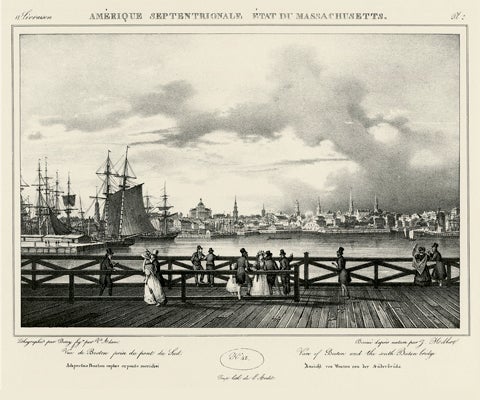
“View of Boston and the South Boston Bridge”
Picturesque Itinerary of the Hudson River and the Peripheral Parts of North America (1828–29)
Jacques-Gérard Milbert (1776–1840)
published in the United States by Gregg Press, Ridgewood, New Jersey (1968)
R2019.0308.003
Views of North America lengths 21–26 c. 2018 (first edition 1834)
“Natural Bridge, Virginia”
Designed by Jean-Julien Deltil (1791–1863)
1,690 printing blocks, 223 colors, and 32 lengths
Zuber et Cie
Rixheim, France
Courtesy of Zuber et Cie
L2019.0301.001.01-.32
The View from France
In an era before photography or cinema, French scenic wallpaper served as a form of escapism and entertainment. Although grounded in authentic geographical and topographical features, Views of North America clearly features an imaginative rendering of its people. Since the American Revolutionary War and the signing of the Declaration of Independence in 1776, the French were enthralled by what they viewed as a fledgling nation in the midst of developing a great democracy. By the 1830s, when designer Jean-Julien Deltil began designing Views of North America numerous published lithographs and travel accounts documenting the region had become available in France.
Deltil’s decision to portray African Americans in formal attire among whites was most likely motivated by several Europeans describing their surprise at encountering prosperous, free African Americans during their travels to Eastern cities such as New York and Philadelphia. At the request of Zuber, Deltil also depicted a group of Native Americans in the “Dance of the American Warriors” scene. Guided by lithographs published in the 1830s under the direction of Thomas McKenney, head of the United States Bureau of Indian Affairs, Deltil borrowed liberally from these plates, adorning his figures in the colorful clothing of Creek, Shawnee, and other nations.
Deltil’s portrait of Americans of both European and African descent freely mixing and Native Americans performing before the two groups certainly reflects an inaccurate chronicle of pre-industrial life in America. Nevertheless, in 1834, the harmonious interpretation provided a romanticized panorama suitable for the walls of one’s home and aligned with many French and Europeans view of North America as a remarkable social experiment set in marvelous landscape.
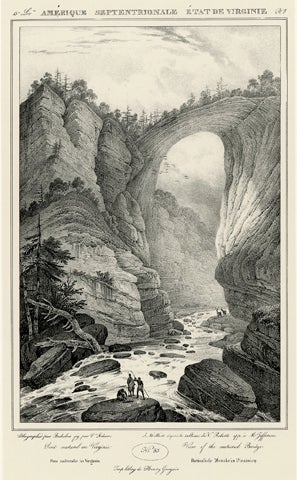
“View of the Natural Bridge”
Picturesque Itinerary of the Hudson River and the Peripheral Parts of North America (1828–29)
Jacques-Gérard Milbert (1776–1840)
published in the United States by Gregg Press, Ridgewood, New Jersey (1968)
R2019.0308.004
Views of North America lengths 27–32 c. 2018 (first edition 1834)
”Niagara Falls”
Designed by Jean-Julien Deltil (1791–1863)
1,690 printing blocks, 223 colors, and 32 lengths
Zuber et Cie
Rixheim, France
Courtesy of Zuber et Cie
L2019.0301.001.01-.32
La Guerre de l’Indépendance Américaine
In 1852, nearly twenty years after releasing Views of North America (1834), Zuber et Cie introduced La Guerre de l’Indépendance Américaine (The American War of Independence). The scenic wallpaper has the same background as Views of North America; however, the figures in the foreground have been changed to Revolutionary War soldiers. The wallpaper includes scenes of George Washington entering Boston and the capitulation of British General Charles Cornwallis. Originally, the figures were painstakingly painted by hand rather than block printed.
The 1876 Centennial International Exhibition in Philadelphia sparked the Colonial Revival in the United States, igniting an interest in early American history and architecture, which continued into the early twentieth century. Both Views of North America and The American War of Independence were perfectly suited to Colonial Revival tastes. Nancy McClelland’s seminal 1924 publication, Historic Wall-Papers, also inspired numerous home decorators to adorn their walls with scenic papers. As a result of the new demand for these two scenic paper sets, in the late 1920s, Zuber et Cie carved printing blocks of the Revolutionary War soldiers. In 1961, just as she had for the Diplomatic Reception Room, First Lady Jacqueline Kennedy papered the President’s Dining Room with The American War of Independence.

“Niagara Falls from the American Side”
Picturesque Itinerary of the Hudson River and the Peripheral Parts of North America (1828–29)
Jacques-Gérard Milbert (1776–1840)
published in the United States by Gregg Press, Ridgewood, New Jersey (1968)
R2019.0308.005
Artisans use the original antique printing blocks, which the
French Ministry of Culture has designated as Historical Monuments;
Zuber Factory, Rixheim, France
Photograph by Fanny LaTour
Zuber: Two Centuries of Panoramic Paper (2019)
Brian D. Coleman
Courtesy of Gibbs Smith, Layton, Utah
R2019.0304.013
Crafting Scenic Wallpaper
Zuber et Cie currently produces fourteen scenic paper sets using the original antique printing blocks. The firm also reproduces many other scenic papers that they or other historic wallpaper firms once made using various printing techniques because the original printing blocks have been lost or destroyed.
Originally, handmade paper was created from processed linen rags; small sheets were pasted together to form rolls. Machine-made paper gradually began to replace handmade paper beginning in the 1830s. Given the ephemeral nature of paper, surviving nineteenth-century scenic wallpapers attest to the high quality of both the hand and machine-made papers.
Ample sky fills the top of scenic wallpapers to allow for trimming to various ceiling heights. To create Zuber’s superbly tinted skies, artisans use a special technique, carefully shading the base color a stronger blue near the top of the paper to paler tints near the horizon line of a scene, often including shades of golden yellow. These softly fading skies are a Zuber trademark. Because the skies are hand painted and the wallpapers are entirely block printed by hand, no two sets of scenic wallpaper are exactly the same.
Distemper paint, which is used to block-print designs onto rolls of paper, creates a unique, textured look. It often takes more than one thousand blocks to create a panoramic paper set. For instance, if there are several colors on one leaf in a scenic paper, each color is applied with a separate printing block. Printing blocks were created in layers in order to prevent the blocks from warping. Whitewood or pine was used underneath, and sycamore or pear tree wood was preferred as the top carved layer due to the fineness of the grain.
